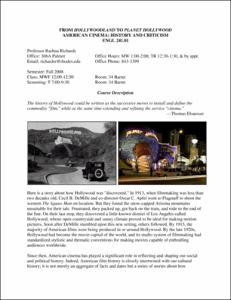Please use this identifier to cite or link to this item:
http://hdl.handle.net/10267/3451| Title: | ENGL 241-01, From Hollywood to Planet Hollywood, American Cinema: History and Criticism, Fall 2008 |
| Authors: | Richards, Rashna |
| Keywords: | English, Department of;Syllabus;Text;Curriculum;2008 Fall |
| Issue Date: | 27-Aug-2008 |
| Publisher: | Memphis, Tenn. : Rhodes College |
| Series/Report no.: | Syllabi CRN 19489 |
| Abstract: | Here is a story about how Hollywood was "discovered." In 1913, when filmmaking was less than two decades old, Cecil B. DeMille and co-director Oscar C. Apfel went to Flagstaff to shoot the western The Squaw Man on location. But they found the snow-capped Arizona mountains unsuitable for their tale. Frustrated, they packed up, got back on the train, and rode to the end of the line. On their last stop, they discovered a little-known district of Los Angeles called Hollywood, whose open countryside and sunny climate proved to be ideal for making motion pictures. Soon after DeMille stumbled upon this new setting, others followed. By 1915, the majority of American films were being produced in or around Hollywood. By the late 1920s, Hollywood had become the movie capital of the world, and its studio system of filmmaking had standardized stylistic and thematic conventions for making movies capable of enthralling audiences worldwide. Since then, American cinema has played a significant role in reflecting and shaping our social and political history. Indeed, American film history is closely intertwined with our cultural history; it is not merely an aggregate of facts and dates but a series of stories about how Hollywood has developed as an art and an industry, an imaginary pleasure and a symbolic language, a hallucination and a fact. This course tells those stories by tracing the evolution of American narrative cinema from its beginnings in the nickelodeons to its worldwide dominance during the studio era to its rebirth as a countercultural medium to its most recent transformation as a "transnational" cinema in today's global cultural marketplace. We will begin the semester by sketching the rise and fall of the studio system within the context of tumultuous historical events, major economic changes, and noteworthy technological breakthroughs. Then, we will turn to the emergence of a New Hollywood, born out of the turmoil of counterculture movements and then altered radically by growing media conglomerations, new exhibition formats, and the transnationalization of the American film industry. In the final unit, we will move from film history to film criticism and examine how millennial fears and anxieties about the future inform contemporary American cinema. Along the way, we will explore the notion of classical cinema; investigate Hollywood's ideological influence on American culture; and assess the cultural, technological, and industrial changes that have occurred in American film practice during the "century of cinema." |
| Description: | This syllabus was submitted to the Office of Academic Affairs by the course instructor. |
| URI: | http://hdl.handle.net/10267/3451 |
| Appears in Collections: | Course Syllabi |
Files in This Item:
| File | Description | Size | Format | |
|---|---|---|---|---|
| 2008_fall_ENGL_241_01_19489.pdf | 64.39 kB | Adobe PDF |  View/Open |
Items in DSpace are protected by copyright, with all rights reserved, unless otherwise indicated.